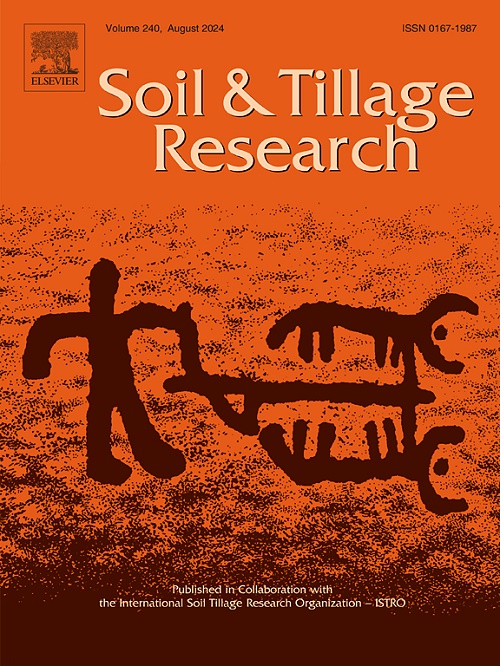全面说明通过水旱轮作改善土壤条件和水稻生产,促进农业可持续发展
IF 6.1
1区 农林科学
Q1 SOIL SCIENCE
引用次数: 0
摘要
水旱轮作是改善土地利用和粮食生产的有效方法,在农业可持续发展中发挥着重要作用。然而,它们对土壤条件、水稻发育和经济效益的影响尚未得到系统的研究。在本研究中,我们研究了7年(2016-2022)稻田休耕(R-F)、水稻-油菜移栽(R-tRS)、水稻-小麦(R-W)和水稻-油菜直播(R-dRS)对水稻产量的影响:1)水稻产量;灌浆期籽粒淀粉生物合成的关键酶和基因;3)水稻土理化性质、土壤酶活性、微生物;4)年经济效益。结果表明,连续轮作7年,特别是稻-油菜轮作,通过增加有机质、全氮含量、土壤蔗糖酶、磷酸酶、脲酶、脱氢酶和纤维素酶,抑制pH、速效氮和磷含量的下降,有助于改善土壤质量。由于土壤条件的改善,R-dRS的水稻产量最高,为7800.3 kg·ha - 1,比R-F、R-tRS和R-W分别提高了14.3%、4.8%和6.3 %,主要原因是有效穗数的增加。灌浆期淀粉生物合成相关酶活性和基因表达量的增加也增加了籽粒淀粉含量;因此,R-dRS的毛利率最高,为1676.5美元·ha - 1,与R-F、R-tRS和R-W相比,分别增长了74.9 %、14.9 %和19.7 %。此外,通过细菌16S和真菌ITS测序,利用线性判别分析(LDA)、效应大小(LEfSe)和Mantel方法鉴定出与土壤性状和水稻产量性状密切相关的关键微生物。综上所述,我们验证了水旱作轮作,特别是旱作轮作在土壤改良、植物生长和经济效益方面的优势。确定了土壤理化性质、关键微生物、土壤条件改善对水稻灌浆的纵向变化趋势,为粮食安全与可持续发展提供理论依据。本文章由计算机程序翻译,如有差异,请以英文原文为准。
Comprehensive illustration of the improvement of soil conditions and rice production through paddy-upland rotations for sustainable agricultural development
Paddy-upland rotations are promising methods to improve land utilization and grain production and play crucial roles in sustainable agricultural development. However, their effects on soil conditions, rice development, and economic benefits have not yet been systematically investigated. In this study, we investigated the effects of 7 years (2016–2022) of continuous rotation of rice fallow (R-F), rice-rapeseed transplanting (R-tRS), rice-wheat (R-W), and rice-rapeseed direct seeding (R-dRS) on: 1) rice production; 2) key enzymes and genes related to grain starch biosynthesis during the filling stages; 3) paddy soil physiochemical properties, soil enzyme activities, and microbes; and 4) annual economic benefits. Our results showed that 7 years of continuous rotations, especially rice-rapeseed rotations, helped improve soil quality by increasing the organic matter, total nitrogen content, soil sucrase, phosphatase, urease, dehydrogenase, and cellulase, and inhibiting the decrease in pH, available nitrogen, and phosphorous contents. Benefitted by the improved soil conditions, R-dRS showed the highest rice yield of 7800.3 kg·ha−1, revealing increases of 14.3, 4.8, and 6.3 % compared with R-F, R-tRS, and R-W, respectively, mainly owing to the increase of effective panicle numbers. Moreover, the grain starch contents also increased owing to the increase of starch-biosynthesis-related enzymes activities and gene expression in the filling stages; consequently, R-dRS resulted in the most gross margins of 1676.5 dollars·ha−1, with increases of 74.9 %, 14.9 %, and 19.7 % compared with R-F, R-tRS, and R-W. Furthermore, key microbes closely related to soil properties and traits of rice yield were identified using the liner discriminant analysis (LDA) effect size (LEfSe) and Mantel methods after bacterial 16S and fungal ITS sequencing. In conclusion, we validated the advantages of paddy-upland rotation, especially R-dRS, in terms of soil improvement, plant growth, and economic benefits. The longitudinal variation trends of annual soil physiochemical properties, key microbes, and the influence of improved soil conditions on rice grain filling were identified, providing a theoretical basis for food security and sustainability.
求助全文
通过发布文献求助,成功后即可免费获取论文全文。
去求助
来源期刊

Soil & Tillage Research
农林科学-土壤科学
CiteScore
13.00
自引率
6.20%
发文量
266
审稿时长
5 months
期刊介绍:
Soil & Tillage Research examines the physical, chemical and biological changes in the soil caused by tillage and field traffic. Manuscripts will be considered on aspects of soil science, physics, technology, mechanization and applied engineering for a sustainable balance among productivity, environmental quality and profitability. The following are examples of suitable topics within the scope of the journal of Soil and Tillage Research:
The agricultural and biosystems engineering associated with tillage (including no-tillage, reduced-tillage and direct drilling), irrigation and drainage, crops and crop rotations, fertilization, rehabilitation of mine spoils and processes used to modify soils. Soil change effects on establishment and yield of crops, growth of plants and roots, structure and erosion of soil, cycling of carbon and nutrients, greenhouse gas emissions, leaching, runoff and other processes that affect environmental quality. Characterization or modeling of tillage and field traffic responses, soil, climate, or topographic effects, soil deformation processes, tillage tools, traction devices, energy requirements, economics, surface and subsurface water quality effects, tillage effects on weed, pest and disease control, and their interactions.
 求助内容:
求助内容: 应助结果提醒方式:
应助结果提醒方式:


